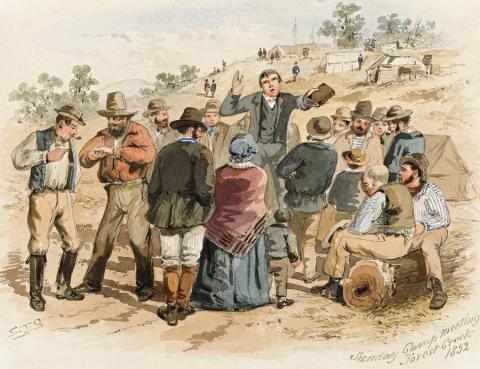SUNDAY CAMP MEETING, FOREST CREEK, 1852
S.T. GILL
watercolour on paper
20.0 x 26.5 cm
signed with initials lower left: S.T.G
titled and dated lower right: Sunday Camp Meeting / Forest Creek / 1852
Private collection
Christies, Melbourne, 11 March 1977, lot 9
Private collection
Leonard Joel, 6 November 1985, lot 30
Wesfarmers Art Collection, Perth (label attached verso)
The Song of the Lamb: The Wesfarmers Collection of Australian Art, Art Gallery of Western Australia, Perth, 19 August – 2 October 1989
The Goldfields Illustrated: The Sketches of S.T. Gill, Lansdowne Press Pty Ltd, Melbourne, 1972, pl. 98 (illus.)
Cannon, M., The Victorian Goldfields1852-3, John Currey O'Neil, Melbourne, 1982, pl. 28 (illus.)
Gooding, J., Topliss, H., Sharkey, C., and Horridge, N., The Song of the Lamb: The Wesfarmers Collection of Australian Art, Art Gallery of Western Australia, Perth,1989, p. 39 (illus.)
Greatly admired as the visual chronicler of the Victorian goldfields, Samuel Thomas Gill, in his own day was an enormously popular artist. His watercolours, lithographs and engravings covered Aboriginal life, inland explorations, and early Adelaide, to life on the Victorian goldfields, of burgeoning Melbourne and Sydney, all peopled with the most colourful of characters. Goldfield scenes attracted worldwide interest; sets of lithographs were published in London as early as 1853, pirated, and even appeared in German. His work was so sought after that special subjects were frequently repeated, often appearing in both watercolour and lithography. The lithographic version of the work on offer first appeared inThe Victoria Gold Diggings And Diggers As They Are published in Melbourne from August 1852. This was only a brief time after Gill sketched it on the spot, for among those original drawings that survived, several indicate that he was at Forest Creek in mid-June of 1852.1
Forest Creek (present day Chewton close to Castlemaine) was part of the fabulously rich Mount Alexander field, which attracted many diggers from South Australia, including Gill, his brother John and friend James Thompson. While they dug, Gill sketched. One of his finest watercolours is Forest Creek, Mount Alexander 1852 in the collection of the State Library of Victoria, Melbourne. The square shown in the watercolour was a popular meeting place for the diggers. Open-air church services were held there on Sundays. With a quick eye for character and the humorous, Gill surrounded the Bible-holding preacher with a crowd of mixed interest, of the young and old all attired in their Sunday best. Two diggers to the left, however, were more interested in things earthly. Eyes raised heavenwards, the sermoniser was, no doubt, urging his flock not to put too much trust in worldly riches. Gill had more than a passing knowledge of the subject for his father, the Reverend Samuel Gill, was a Baptist minister. Although work was not allowed on the diggings on Sundays, boxing often enlivened the afternoons and vied with the preachers for attention. Gill captured one of the bare-knuckled fights in A Bendigo Mill, June 20 1852, again in both watercolour and lithography. Significantly, the name 'Bendigo' was derived from that of a famous nineteenth-century English boxer called 'Abednego' Thompson. In these and other fascinating works, Gill captured those special facets of the Australian character of independence, resilience, and scepticism, touched with a bit of irreverence, in treasured images of our history that have become part of our national mythology.
1. S.T. Gill, Digger's Hut, Canvas and Bark, Forest Creek, June 16th, pencil on paper, 10.1 x 16.3 cm, in Original Drawings of the Victorian Goldfields, 1852, Mitchell Library, State Library of New South Wales, Sydney
DAVID THOMAS
